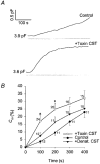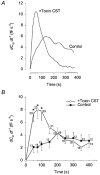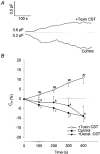Actin cytoskeleton depolymerization with clostridium spiroforme toxin enhances the secretory activity of rat melanotrophs
- PMID: 10581310
- PMCID: PMC2269662
- DOI: 10.1111/j.1469-7793.1999.00389.x
Actin cytoskeleton depolymerization with clostridium spiroforme toxin enhances the secretory activity of rat melanotrophs
Abstract
1. We measured membrane capacitance (Cm) in cultured rat melanotrophs pretreated with Clostridium spiroforme toxin (CST), which specifically depolymerizes cortical filamentous actin (F-actin). Phalloidin staining confirmed that CST treatment depolymerised the F-actin. 2. In control cells, cytosol dialysis with 1 microM Ca2+i increased Cm by 23 +/- 4 % (n = 11) relative to the resting Cm 400 s after the start of patch rupture. In CST-treated cells the increase in Cm was 32 +/- 5 % (n = 15), not significantly different from controls. The rate of Cm increase was affected transiently by CST treatment, peaking at 1 min after patch rupture. The maximal rate of Cm increase was 4.27 +/- 0.85 fF s-1 (n = 12; measured 200 s after the start of patch rupture) in controls and 8.0 +/- 1.35 fF s-1 (n = 23; measured 75 s after the start of patch rupture) in CST-treated cells (P < 0.01). 3. In control cells cytosol dialysis with 0 microM Ca2+i decreased Cm by 9 +/- 3 % (n = 7), in CST-treated cells Cm increased by 11 +/- 3 % (n = 7) relative to resting Cm 400 s after the start of cytosol dialysis. The rate of change in Cm remained constant (controls: -1 to -2 fF s-1; CST treatment: 1-2 fF s-1). 4. Transient and sustained effects of CST treatment on changes in Cm at high or low [Ca2+]i, respectively, suggest a distinct role of cytoskeleton in Ca2+-dependent and Ca2+-independent changes in Cm. Transient enhancement of the rate of Cm by CST is consistent with a barrier role of cytoskeleton in regulated exocytosis. The sustained effect of CST on Ca2+-independent changes in Cm suggests cytoskeletal involvement in endocytosis.
Figures




Similar articles
-
Distinct effect of actin cytoskeleton disassembly on exo- and endocytic events in a membrane patch of rat melanotrophs.J Physiol. 2002 Dec 15;545(3):879-86. doi: 10.1113/jphysiol.2002.028043. J Physiol. 2002. PMID: 12482893 Free PMC article.
-
Actin cytoskeleton and exocytosis in rat melanotrophs.Pflugers Arch. 2000;439(3 Suppl):R148-9. Pflugers Arch. 2000. PMID: 10653173
-
Actin cytoskeleton and exocytosis in rat melanotrophs.Pflugers Arch. 2000 Jan;439(Suppl 1):r148-r149. doi: 10.1007/s004240000125. Pflugers Arch. 2000. PMID: 28176104
-
[Analysis of synaptic neurotransmitter release mechanisms using bacterial toxins].J Soc Biol. 1999;193(6):457-67. J Soc Biol. 1999. PMID: 10783704 Review. French.
-
[Bacterial toxins: useful for studying G-proteins implicated in the mechanism of exocytosis in neuroendocrine cells].J Soc Biol. 1999;193(6):451-6. J Soc Biol. 1999. PMID: 10783703 Review. French.
Cited by
-
Physical mobilization of secretory vesicles facilitates neuropeptide release by nerve growth factor-differentiated PC12 cells.J Physiol. 2002 Jul 15;542(Pt 2):395-402. doi: 10.1113/jphysiol.2002.021733. J Physiol. 2002. PMID: 12122140 Free PMC article.
-
Distinct effect of actin cytoskeleton disassembly on exo- and endocytic events in a membrane patch of rat melanotrophs.J Physiol. 2002 Dec 15;545(3):879-86. doi: 10.1113/jphysiol.2002.028043. J Physiol. 2002. PMID: 12482893 Free PMC article.
-
Coordinated oscillations in cortical actin and Ca2+ correlate with cycles of vesicle secretion.Nat Cell Biol. 2012 Dec;14(12):1261-9. doi: 10.1038/ncb2614. Epub 2012 Nov 11. Nat Cell Biol. 2012. PMID: 23143397 Free PMC article.
-
Facilitation of Ca(2+)-dependent exocytosis by Rac1-GTPase in bovine chromaffin cells.J Physiol. 2003 Jul 15;550(Pt 2):431-45. doi: 10.1113/jphysiol.2003.039073. Epub 2003 May 16. J Physiol. 2003. PMID: 12754309 Free PMC article.
-
Signaling mechanisms of glucose-induced F-actin remodeling in pancreatic islet β cells.Exp Mol Med. 2013 Aug 23;45(8):e37. doi: 10.1038/emm.2013.73. Exp Mol Med. 2013. PMID: 23969997 Free PMC article. Review.
References
-
- Böttinger H, Reuner KH, Aktories K. Inhibition of histamine release from rat mast cells by botulinum C2 toxin. International Archives of Allergy and Applied Immunology. 1987;84:380–384. - PubMed
-
- Burgoyne RD. Secretory vesicle-associated proteins and their role in exocytosis. Annual Review of Physiology. 1990;52:647–659. - PubMed
-
- Cheek TR, Burgoyne RD. Nicotine-evoked disassembly of cortical actin filaments in adrenal chromaffin cells. FEBS Letters. 1986;207:110–114. - PubMed
-
- Considine RV, Simpson LL. Cellular and molecular actions of binary toxins possessing ADP-ribosyltransferase activity. Toxicon. 1991;29:913–936. - PubMed
Publication types
MeSH terms
Substances
LinkOut - more resources
Full Text Sources
Miscellaneous

